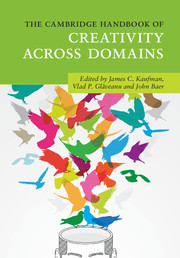Book contents
- The Cambridge Handbook of Creativity Across Domains
- The Cambridge Handbook of Creativity Across Domains
- Copyright page
- Dedication
- Contents
- Figures
- Tables
- Contributors
- Acknowledgments
- Part I Creativity and Domain
- Part II Creativity in the Traditional Arts
- Part III Creativity in the Sciences
- Part IV Creativity in Business
- Part V Newer Domains for Creativity Research
- 24 Intellectual Property
- 25 Gastronomy and Culinary Creativity
- 26 Tactical Creativity in Sport
- 27 Creativity in Non-Human Animals
- 28 Violent Innovation
- Part VI Creativity in Everyday Life
- Part VII Conclusion
- Index
- References
26 - Tactical Creativity in Sport
from Part V - Newer Domains for Creativity Research
Published online by Cambridge University Press: 15 September 2017
- The Cambridge Handbook of Creativity Across Domains
- The Cambridge Handbook of Creativity Across Domains
- Copyright page
- Dedication
- Contents
- Figures
- Tables
- Contributors
- Acknowledgments
- Part I Creativity and Domain
- Part II Creativity in the Traditional Arts
- Part III Creativity in the Sciences
- Part IV Creativity in Business
- Part V Newer Domains for Creativity Research
- 24 Intellectual Property
- 25 Gastronomy and Culinary Creativity
- 26 Tactical Creativity in Sport
- 27 Creativity in Non-Human Animals
- 28 Violent Innovation
- Part VI Creativity in Everyday Life
- Part VII Conclusion
- Index
- References
Summary
The objective of this chapter is to give an overview of literature on tactical creativity in team sports. After stressing the relevance and definitions of tactical creativity in team sports, the advantages and disadvantages of different tests (video tests, game test situations, and game observation) to measure tactical creativity are compared with one another. The main focus lies on the introduction of the tactical creativity approach (TCA) for team sports, which summarizes seven methodological principles fostering tactical creativity. All these principles (1-dimension games, diversification, deliberate practice, deliberate play, deliberate coaching, deliberate memory, and deliberate motivation) are discussed following an overview of their empirical background. This chapter is enclosed by directions for potential further research with links to other research topics.
- Type
- Chapter
- Information
- The Cambridge Handbook of Creativity across Domains , pp. 479 - 491Publisher: Cambridge University PressPrint publication year: 2017
References
- 6
- Cited by



